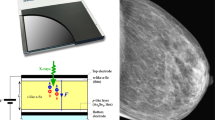Abstract
A series of a-Se:Te photoconductor films of thickness 60 μm were prepared by conventional vacuum deposition onto heated Al substrates to study fractionation effects. There is a Te-rich surface region, a plateau of relatively “uniform” bulk region, and a Se-rich zone near the substrate. For a source material of Se:12.5% Te (all compositions in wt %), the substrate surface of the film was about 5.5–6.2% Te and the top surface was Te-rich up to about 25% Te content. The plateau region is between approximately 10 μm to 40 μm from the substrate and has about ∼10% Te. The existence of the plateau region provides a means of preparing relatively homogeneous films by suitably shuttering the substrate during the evaporation to capture this plateau region. A first-order fractionation model of the evaporation process was developed to account for the observed compositional variation across the films. The fractionation model applies concepts from mass transport to the melt by considering a surface region (SR) of a fixed number of atoms in which rapid diffusional changes maintain a relatively uniform Te composition that changes over the course of the evaporation process. The model is able to explain the general features of the experimental results and is in reasonable quantitative agreement with the experiments. A series of nearly homogeneous a-Se1-xTet films (composition homogeneous to within 10%) were prepared by suitably shuttering the vacuum deposition process to capture the plateau region. Charge transport in both homogeneous and fractionated films was studied using the conventional time-of-flight (TOF) and interrupted time-of-flight (IFTOF) transient photoconductivity experiments. As a-Se is alloyed with Te, the hole drift mobility μh decreases rapidly with the Te content up to about ∼5% Te beyond which the decrease in the mobility becomes small. Both hole and electron drift mobility has been found to depend on the electric field E as μ ∝ E n where n is a small index that increases with the Te content in agreement with earlier work on probably fractionated samples. Consequently, the power law dependence is not an artifact of the fractionation effect. Hole lifetime in Cl-doped a-Se:Te films from IFTOF experiments was found to increase with the Te composition, nearly in proportion to the decrease in the drift mobility, in agreement with the shallow-trap-controlled model proposed for hole transport in a-SeTe films.
Similar content being viewed by others
References
L. Cheung, G. M. T. Foley, P. Fournia and B. E. Springett, Photogr. Sci. Eng. 26 (1982) 245.
B. E. Springett, Proceedings of the Third International Symposium on Industrial Cases of Selenium and Tellurium (Selenium-Tellurium Development Association, Inc., Grimbergen, Belgium, 1984) p. 258.
Idem., Phosphorus and Sulphur 38 (1988) 341.
Idem., Proceedings of the Fourth International Symposium on Uses of Selenium and Tellurium, (Selenium-Tellurium Development Association, Inc., Grimbergen, Belgium, 1984) p. 126.
S. O. Kasap, “Photoreceptors: The Chalcogenides” in “The Handbook of Imaging Materials, edited by A. Diamond (New York, Marcel Dekker, 1991) or Ch. 8 and references therein.
K. Tanioka, J. Yamazaki, K. Shidara, K. Taketoshi, T. Hirai and T. Y. Takasaki, Adv. Electron. Electron Phys. 74 (1988) 379.
K. Tsuji, T. Ohshima, T. Hirai, N. Gotoh, K. Tanioka and K. Shidara, Mater. Res. Soc. Symp. Proc. 219 (1991) 505.
J. S. Berkes, in Electrophotography: Second International Conference edited by D. R. White (Society of Photographic Scientists and Engineers, Springfield, VA, 1974) p. 137.
A. G. S Igai, J. Vac. Sci. Technol. 12 (1975) 958.
M. Holdon, Proceedings of the Fourth International Symposium on Uses of Selenium and Tellurium (Selenium-Tellurium Development Association, Darien, CT, 1989).
S. O. Kasap and B. Polischuk, Can. J. Phys. 73 (1995) 96.
S. M. Vaezi-NEIAD and C. Juhasz, Thin Solid Films 148 (1987) 251.
M. Abkowitz and J. M. Markovics, Solid State Commun. 44 (1982) 1431.
S. O. Kasap, B. Polischuk and D. Dodds, Rev. Sci. Instrum. 61 (1990) 2081.
J. C. Schottmiller, J. Vac. Sci. Technol. 12 (1975) 807.
S. M. Vaezi-Nejad and C. Juhasz, Semicond. Sci. Technol. 2 (1987) 809.
S. O. Kasap and C. Juhasz, J. Mater. Sci. 21 (1986) 1329.
Q. Zhang and C. H. Champness, Can. J. Phys. 69 (1990) 278.
S. O. Kasap and C. Juhasz, J. Mater. Sci. Lett. 6 (1987) 397.
J. Drowart, S. Smoes and A. M. VanderAuweramathieu in Proceedings of the Third International Symposium on Industrial Uses of Selenium and Tellurium (Stockholm, Sweden, 1985) p. 323.
V. V. Illarinov and L. M. Lapina, Sov. Phys. Dokl. 114 (1957) 615.
G. C. Das, M. B. Bever and D. R. Uhlmann, J. Non-Cryst. Solids 7 (1972) 251.
D. M. Paiin J. Stuke and W. Brenig (Eds) “Amorphous and Liquid Semiconductors”, Proceedings of the Fifth International Conference on Amorphous and Liquid Semiconductors, Garmish-Partenkirchen, Germany, 1974 (Taylor and Francis, London, 1974) p. 355.
S. M. Vaezi-Nejad, IOP Conf. Ser. 89 (1987) 283.
Y. Wang and C. H. Champness, J. Appl. Phys. 77 (1995) 722.
S. O. Kasap and C. Juhasz, J. Non-Cryst. Solids 72 (1985) 23.
Author information
Authors and Affiliations
Rights and permissions
About this article
Cite this article
Juhasz, C., Gembala, V. & Kasap, S.O. Vacuum deposited amorphous Se-Te photoconductor films: fractionation effects and charge transport in homogeneous films. Journal of Materials Science: Materials in Electronics 10, 633–641 (1999). https://doi.org/10.1023/A:1008960301920
Issue Date:
DOI: https://doi.org/10.1023/A:1008960301920




